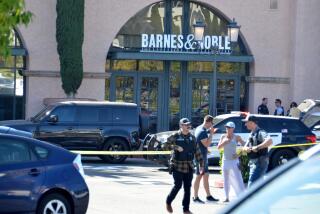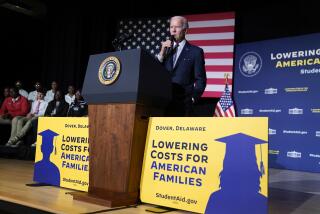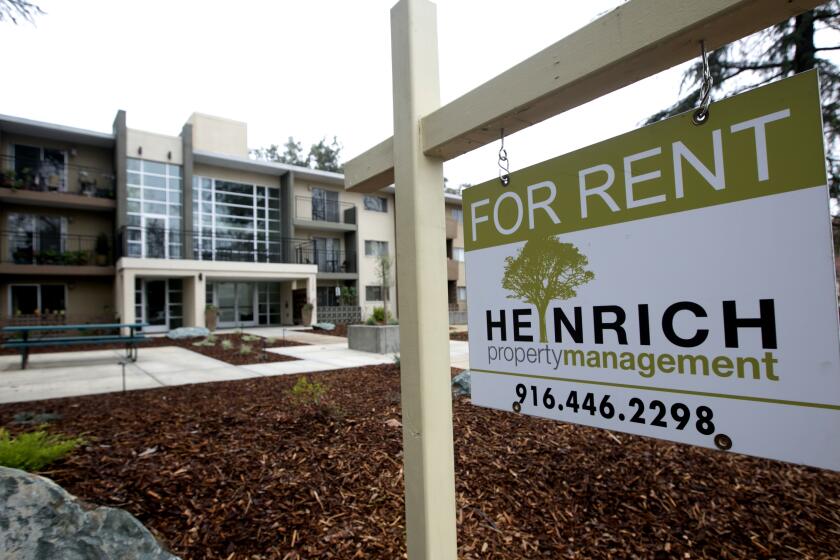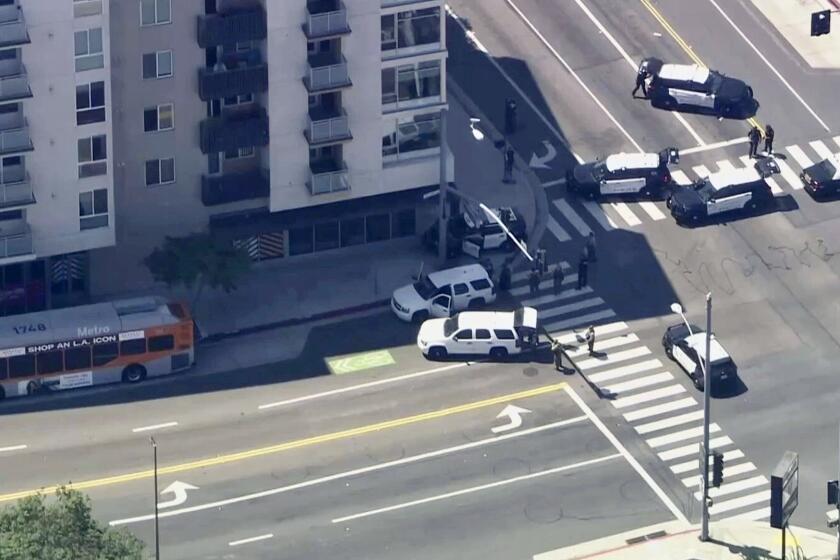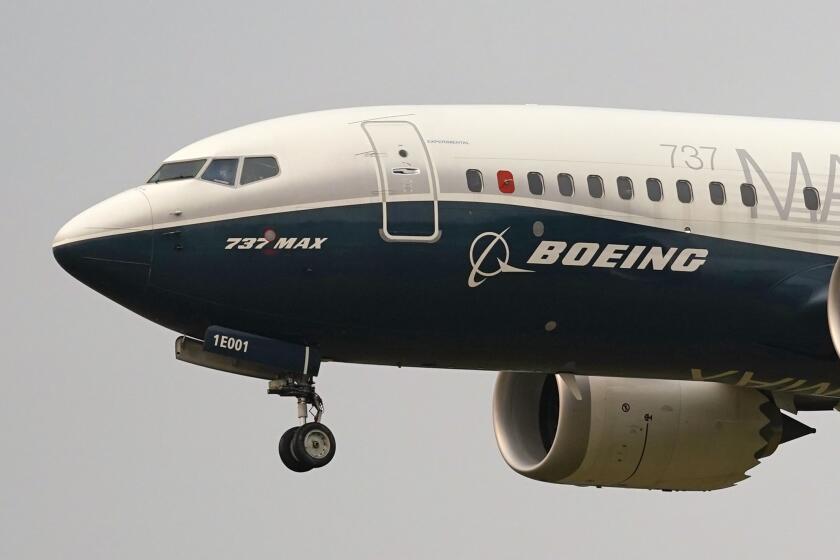After Decades of Debate, Century Freeway to Open : Transit: $2.2-billion project has torn apart lives and communities but also brought job training and housing.
The Century Freeway, a 17-mile stretch of concrete running between Norwalk and El Segundo, opens this week, capping 30 years of bitter debate and leaving a dubious legacy: No freeway in the nation has cost more or created as much havoc.
The Century Freeway sliced neighborhoods in two, tore through well-tended homes and displaced about 21,000 people living in its path. It created a wasteland roamed by vandals, a place where bodies and sofas were unceremoniously dumped.
But the $2.2-billion project also has given the communities something in return. It is the only freeway that has provided housing and job training. It also has employed more women and minorities than any other transportation enterprise in California.
But some question whether the benefits have come at too high a cost. They wonder if the communities decimated by the freeway’s route will ever recover. And they speculate that in the future, projects with such tradeoffs might not survive.
“If we were starting today to consider whether or not to build the freeway, we might come up with another conclusion,” said Martin Wachs, professor of urban planning and dean of transportation studies at UCLA. “Society in the 1990s is less willing to put in a facility which benefits many a little bit but imposes enormous costs on communities.”
Lowell Berwick is among those who have seen the project’s cost reflected in their lives.
Three decades ago, the Century Freeway claimed the house in Hawthorne that Berwick purchased as a young newlywed. But the route was changed, and in 1987, officials seized Berwick’s radiator repair shop--a building that he had specially designed for his business.
Berwick, 51, will never forgive the state of California for “taking and stepping on the little guy.” He is convinced that a recent heart attack resulted from the stress he suffered at the hands of the California Department of Transportation. Sometimes he visits his old neighborhood even though he knows how much it distresses him.
“I put my heart and soul in that business for 15 years,” said Berwick, who now lives in San Diego County. “It’s like visiting a grave site of a family member; it dredges up a lot of memories.”
The freeway project took so long that it outlived some of its opponents, such as Ralph Keith.
Keith and his wife, Esther, had moved from Pennsylvania to Hawthorne in 1947, when the region was dotted with farms. They chose Hawthorne for its beauty and its proximity to the airport, where Ralph worked.
Decades later, they balked when the state demanded that they relinquish their home; instead, they joined three other couples in filing a suit that delayed the freeway. “If it had been for anything but that project, we would have gritted our teeth and said, ‘OK, it’s needed,’ but we thought the freeway was the last thing it should go for,” said Esther Keith, 72. “I shudder to think what it’s going to do to the environment.”
Ralph Keith died 11 years ago. Esther Keith now lives two blocks from her former home, easily able to see the freeway that caused her such heartache.
“The freeway hasn’t made it up to the residents who were inconvenienced, but if you look at the communities as an entity, they will reap benefits,” said federal Appellate Judge Harry Pregerson, who turns 70 this week and has presided over litigation involving the project since 1972.
Reaching the eastern edge of Los Angeles International Airport, the Century Freeway hosts a trolley line in its median, six lanes for regular traffic and two for car pools. It is equipped with closed-circuit television cameras and traffic sensors.
The freeway is expected to carry between 8,000 and 12,000 vehicles per hour, traveling in both directions, during prime commuting times. In off-peak hours, it will carry about 7,000 per hour, said Chuck O’Connell, chief of Caltrans’ district maintenance field branch. (By comparison, 15,000 to 20,000 travel the Santa Monica Freeway during rush hour; about 12,000 during off-peak hours.)
Initially, the new freeway could reduce traffic on surrounding surface streets by up to 25%, O’Connell said. It is also expected to ease congestion on the region’s freeway network by about 10%. For drivers, the typical 20-minute trip might be two to three minutes shorter, or up to a 15% savings in time.
In hopes of managing traffic and preventing the Century Freeway from clogging, Caltrans installed freeway-to-freeway meters, until now used only on an experimental basis.
Even so, some experts say this freeway--like others in the region--will inevitably be inundated by cars. They cite what has become the traffic rule of thumb: “If you build it, they will come.”
“In a matter of months, it’s going to fill up. It’ll relieve some congestion, but it’s not going to be any sort of panacea that clears out all congestion problems,” said Robert Kleinhenz, a Cal State Fullerton economist.
When officials first started planning the Century Freeway during the 1950s, they viewed it as an essential link in the region. The California Legislature had mapped out an elaborate network of freeways that would have placed every Angeleno within several miles of a freeway.
But many of these planned roadways--such as the Beverly Hills and Malibu freeways--never got off the drawing board. Highways here and in Boston, New York, Memphis, New Orleans and San Francisco were quashed by the “Freeway Revolt,” as more and more communities dug in their heels during the ‘60s and ‘70s.
The Century Freeway squeaked through, but not untouched. In February, 1972, a month before construction was slated to begin, the behemoth project was stopped by the lawsuit filed by the Keiths and others, including the National Assn. for the Advancement of Colored People, Sierra Club, Environmental Defense Fund, Freeway Fighters and the city of Hawthorne. The litigation dragged on for almost a decade.
As a result, the project, which ordinarily would have taken no more than 10 years, consumed 23. All the while, the hardships suffered by communities surrounding highway construction worsened. Weeds, graffiti and vandalism thrived in what had once been well-kept neighborhoods. The freeway project became synonymous with urban decay and blight.
The uncertainty of whether the freeway would be constructed had a devastating effect on most neighborhoods, said John Phillips, a lawyer who represented the Keiths and the others. “Communities were just dying. People began to leave and never came back. Communities lost their sense of identity.”
After a decade of litigation, a deal was struck. Pregerson issued a consent decree requiring the California Department of Transportation, which would build the project, and the Federal Highway Administration, which would pay 92% of its costs, to mitigate the damage caused as the freeway cut through nine cities.
In response to opposition, including that of then-Gov. Edmund G. (Jerry) Brown Jr., the freeway was dramatically scaled down from the original plans that called for 10 lanes running east-west for 51 miles, stretching from San Bernardino to the coast. The result was a 17-mile, eight-lane freeway. The route was given a bell-shaped curve to avoid slicing through Hawthorne.
The agreement also created several unique projects, including the construction or rehabilitation of 7,000 housing units and a job-training program.
The low- and moderate-income housing program, which resulted in 15,000 jobs, established an array of homes, including apartment complexes that offer after-school tutoring. Of the 3,426 who graduated from the job-training program, 2,680 were placed in entry-level construction jobs.
“When this started out, I don’t think anyone dreamed that it could develop into a tremendous social program--which it is--and a great experiment,” Pregerson said.
With inflation and the changing scope of the project, the price tag of the Century Freeway grew to $550 million in 1972. Today, the tally has reached $2.2 billion, which does not include the cost of building the 22-mile trolley--another $720 million that will be paid by the Metropolitan Transportation Authority.
Officials decided in 1987 to name the freeway after Rep. Glenn Anderson, who was instrumental in obtaining federal funding for the project. Most people, however, know it by its early name, the Century Freeway, which originated because at one time it was slated to run along Century Boulevard.
Long before the freeway’s planned opening, some already were reaping the benefits.
Antonio Maceo, like many others, rented a house purchased by the state after the lawsuit halted freeway construction. Later, once disputes over the route were resolved, Maceo and others were allowed to buy their homes at bargain prices. Maceo, 63, a retired car dealer, said he bought a home valued at $217,000 for $50,000.
“Can you imagine getting all this for 50 grand?” said Maceo, proudly pointing to his blue three-bedroom home by the side of the freeway in Inglewood.
In hindsight, some urban planners say the freeway accelerated the deterioration of the communities but was not the sole cause.
“Changes were going on in society--everyone agreed that some cities were negatively impacted by the removal of housing and the creation of giant swaths of barren land,” said Joseph DiMento, professor of social ecology at UC Irvine. “But people were moving out for reasons other than the freeway.”
Even officials from cities that strongly opposed the project now tout it as likely to spur economic growth, revitalizing neighborhoods hit hard by the freeway construction and the recession.
“The real estate community and the business community in the last six months, and from now on, will perceive the whole corridor as a good place to purchase land,” said Hawthorne Mayor Steve Andersen, who once belonged to the Freeway Fighters.
Andersen and others point to areas such as the San Fernando Valley and cities such as Monrovia that benefited from the presence of a freeway. Still, some are skeptical that the freeway will prove to be an economic boon.
“The preferred location these days is suburban location; jobs are moving out, people are moving out,” economist Kleinhenz said. “To get development along the Century Freeway would to some extent be bucking a long-term trend.”
Many experts say environmental laws make it far easier for communities and residents to block major projects such as the Century Freeway. Nor do all Angelenos believe--as many did in the ‘50s--that constructing a highway is the best solution to congestion.
“The social and economic costs--in terms of dollars and disruption to communities--are so high,” said Wachs of UCLA. “There are real benefits to freeways. The key is to get them on the ground early in areas that are going to develop and not to force them through healthy, functioning communities.”
Los Angeles’ newest freeway, even transportation officials say, may be its last.
The Long Road to Completion
* Mid-1950s: Planning begins.
* 1972: Litigation begins in a class-action lawsuit seeking a new environmental impact review; suit was filed by four couples living within the right of way, the National Assn. for the Advancement of Colored People, the Sierra Club, the Environmental Defense Fund, the Freeway Fighters and the city of Hawthorne.
* 1977: The California Highway Commission adopts a modified “bell curve” route to accommodate Hawthorne, which opposed a route that would bisect the city.
* 1979: The class-action suit is settled, and officials are required to relocate or build housing and adopt an affirmative action program to increase the involvement of businesses owned by women and minorities.
* 1981: An amendment in the settlement calls for several features, including six lanes for general traffic and two car-pool lanes, 10 transit stations and park-and-ride lots for a rail line, landscaping and noise attenuation.
* 1982: Freeway construction begins.
* 1983: Housing construction begins.
* 1987: Officials name the freeway in honor of Rep. Glenn Anderson, who was instrumental in obtaining federal funding for the project.
* 1993: Freeway construction ends. Housing construction is scheduled to be complete in 1997.
More to Read
Start your day right
Sign up for Essential California for news, features and recommendations from the L.A. Times and beyond in your inbox six days a week.
You may occasionally receive promotional content from the Los Angeles Times.
